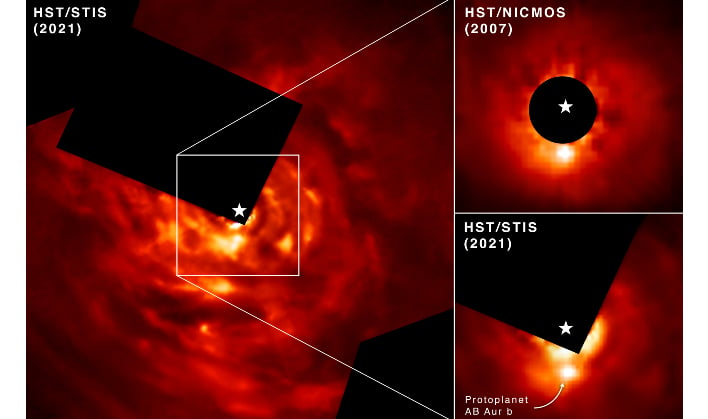Hubble Captures Stunning Images Of A Violent Gaseous Jupiter-Like Planet Formation

Planets are created from material that originated in a circumstellar disk, with the main theory for jovian planet formation being “core accretion.” This theory suggests a bottom-up approach where planets embedded in the disk grow from small objects, ranging in size from dust to boulders, colliding and sticking together as they orbit a star, according to NASA. The disk instability theory contradicts that theory, in that it is a top-down model where a large disk around a star cools, gravity then causes the disk to quickly break apart into one or more planet-mass fragments.
The planet that Hubble spotted, called AB Aurigae b, is believed to be about nine times the size of Jupiter and orbits its host star at an incredible distance of 8.6 billion miles. That is over two times farther away than Pluto is from our own Sun. The fact that the planet is that far away from its star, leads researchers to conclude that it would be highly unlikely it formed using the accretion model. Instead, they believe it could be a result of disk instability that has enabled the planet to form at such a substantial distance.
“Nature is clever; it can produce planets in a range of different ways,” said Thayne Currie of the Subaru Telescope and Eureka Scientific, lead researcher of the study.
The abundance of data was collected using two Hubble instruments: the Space Telescope Imaging Spectrograph and the Near Infrared Camera and Multi-Object Spectrograph. That data was then compared to those from a state-of-the-art planet imaging instrument called SCExAO on Japan’s 8.2-meter Subaru Telescope, which is located atop Mauna Kea, Hawaii.
“Interpreting this system is extremely challenging,” added Currie. “This is one of the reasons why we needed Hubble for this project, a clean image to better separate the light from the disk and any planet.”
Researchers utilized Hubble over a span of 13 years to study AB Aurigae b. It was very helpful that the immense disk of dust and gas swirling around the exoplanet is tilted nearly face-on to our view from Earth.
Currie was at first skeptical that AB Aurigae b was in fact a planet. It was the longevity of Hubble, and its archival data, that provided the evidence that would change his mind. “We could not detect this motion on the order of a year or two years,” stated Currie. “Hubble provided a time baseline, combined with Subaru data, of 13 years, which was sufficient to be able to detect orbital motion.”
Hubble has undoubtedly been a huge help in our current understanding of how planets form and the history of our solar system. As the James Webb Space Telescope readies itself for taking pictures of deep space, that understanding is bound to improve and evolve as new information is revealed through its eyes.
Top Image Courtesy of NASA
NASA’s Hubble Space Telescope has captured evidence of a Jupiter-like protoplanet forming through a “intense and violent” process. The discovery seems to support a highly argued theory for how a planet like Jupiter forms, called “disk instability”.
Planets are created from material that originated in a circumstellar disk, with the main theory for jovian planet formation being “core accretion”. This theory suggests a bottom-up approach where planets embedded in the disk grow from small objects, ranging in size from dust to boulders, colliding and sticking together as they orbit a star, according to NASA. The disk instability theory contradicts that theory, in that it is a top-down model where a large disk around a star cools, gravity then causes the disk to quickly break apart into one or more planet-mass fragments.
The planet that Hubble spotted, called AB Aurigae b, is believed to be about nine times the size of Jupiter and orbits its host star at an incredible distance of 8.6 billion miles. That is over two times farther away than Pluto is from our own Sun. The fact that the planet is that far away from its star, leads researchers to conclude that it would be highly unlikely it formed using the accretion model. Instead, they believe it could be a result of disk instability that has enabled the planet to form at such a substantial distance.
“Nature is clever; it can produce planets in a range of different ways,” said Thayne Currie of the Subaru Telescope and Eureka Scientific, lead researcher of the study.
The abundance of data was collected using two Hubble instruments: the Space Telescope Imaging Spectrograph and the Near Infrared Camera and Multi-Object Spectrograph. That data was then compared to those from a state-of-the-art planet imaging instrument called SCExAO on Japan’s 8.2-meter Subaru Telescope, which is located atop Mauna Kea, Hawaii.
“Interpreting this system is extremely challenging,” added Currie. “This is one of the reasons why we needed Hubble for this project, a clean image to better separate the light from the disk and any planet.”
Researchers utilized Hubble over a span of 13 years to study AB Aurigae b. It was very helpful that the immense disk of dust and gas swirling around the exoplanet is tilted nearly face-on to our view from Earth.
Currie was at first skeptical that AB Aurigae b was in fact a planet. It was the longevity of Hubble, and its archival data, that provided the evidence that would change his mind. “We could not detect this motion on the order of a year or two years,” stated Currie. “Hubble provided a time baseline, combined with Subaru data, of 13 years, which was sufficient to be able to detect orbital motion.”
Hubble has undoubtedly been a huge help in our current understanding of how planets form and the history of our solar system. As the James Webb Space Telescope readies itself for taking pictures of deep space, that understanding is bound to improve and evolve as new information is revealed through its eyes.


